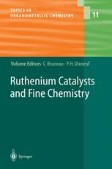Search
Search Results
-
Rhodium/Ruthenium Applications
Asymmetric catalytic hydrogenation and hydrogen transfer reactions of various substrates such as prochiral ketones and olefins using Rh(I) and Ru(II)...
-
An air- and moisture-stable ruthenium precatalyst for diverse reactivity
Versatile, efficient and robust (pre)catalysts are pivotal in accelerating the discovery and optimization of chemical reactions, sha** diverse...

-
Activation of Inert C–H Bonds
The development of catalytic reactions involving carbon–hydrogen bond cleavage is one of the most attractive research subjects in organic and...
-
Determination and Imaging of Small Biomolecules and Ions Using Ruthenium(II) Complex-Based Chemosensors
Luminescence chemosensors are one of the most useful tools for the determination and imaging of small biomolecules and ions in situ in real time....
-
Metal Complexes with Redox-Active Ligands in the Indirect Electrosynthesis of Organic Sulfur Compounds
AbstractA possibility of using metal complexes with redox-active ligands in organic electrosynthesis is demonstrated on the basis of literature data...

-
Photoinduced Electron-Transfer in First-Row Transition Metal Complexes
In this chapter, after a brief summary of the basic photophysical and photochemical concepts, the state of the art of the photoinduced electron...
-
3d-Metal Catalyzed C–C Bond Formation Through α-Alkylation of Ester, Amide, and Nitriles with Alcohol via Dehydrogenative Coupling
The borrowing hydrogenation (BH) and acceptorless dehydrogenative coupling (ADC) methods emerged as sustainable tools for forging carbon–carbon bonds...
-
Metallocene-Catalyzed Selective Reactions
Transition metal cyclopentadienyl complexes constitute a large family of compounds that can be used as catalyst for a number of organic...
-
Novel Catalyst Systems Based on Cationic Palladium Cyclopentadienyl Complexes for the Polymerization of Norbornene and Norbornene Derivatives
AbstractResults of studying the catalytic properties of systems based on complexes with [Pd(Cp)(L) n ] m [BF 4 ] m (where Cp = η 5 -C 5 H 5 ; n = 2, m = 1: L = tris...

-
Electronic Structure and Reactivity of Metal Carbenes
Metal carbenes have for a long time been classified as Fischer or Schrock carbenes depending on the oxidation state of the metal. Since the...
-
Synthesis and Contemporary Applications of Platinum Group Metals Complexes with Acyclic Diaminocarbene Ligands (Review)
AbstractComplexes of platinum group metals with acyclic diaminocarbene ligands have found application as transition metal catalysts, photoluminescent...

-
Water-Soluble Carbon Monoxide-Releasing Molecules (CORMs)
Carbon monoxide-releasing molecules (CORMs) are promising candidates for producing carbon monoxide in the mammalian body for therapeutic purposes. At...

-
Functional Group Directed B–H Activation of Polyhedral Boron Hydrides by Transition Metal Complexes (Review)
AbstractActivation of B–H groups of polyhedral boron hydrides (boranes and carboranes) is one of the most actively develo** areas of boron...

-
Alternative Transformations of N-Heterocyclic Carbene Complexes of the Group 11 Metals in Transmetalation Reactions (A Review)
AbstractThe carbene transfer from N-heterocyclic carbene complexes of Group 11 metals (NHC–M C ) (especially silver and copper) to other metals is...

-
Catalytic Hydrodehalogenation of Haloarenes with Hydrogen and Hydrogen-Containing Compounds: A Review
New catalytic methods for the hydrodehalogenation of haloarenes with hydrogen and hydrogen-containing reagents (metal and non-metal hydrids, organic...

-
Dithiocarboxylic Acid Salts of Group 1–17 Elements (Except for Carbon)
In this chapter, we review dithiocarboxylic acid salts. Methods of synthesizing these salts are reviewed, such as insertion of carbon disulfide into...
-
The Applications of Metal-Based Photocatalysis in Organic Synthesis
Photoredox catalysis is considered as a “hot topic” in organic synthesis, and it is now impossible to count the number of papers that have been...
-
Different Types of Reducing Agents
Following are given different types of reducing agents. As already stated, the method of choice depends on the selectivity required and also on the...
-
Enantioselective Radical Reactions
Over the past two decades, many researchers have been interested in “taming” the reactive free radical intermediate and utilizing it in...
-
Group 1–17 Element (Except Carbon) Derivatives of Thio-, Seleno- and Telluro-Carboxylic Acids
Over the last two decades, our understanding of the chemistry of Group 1–17 element derivatives of chalcogenocarboxylic acids has improved...
